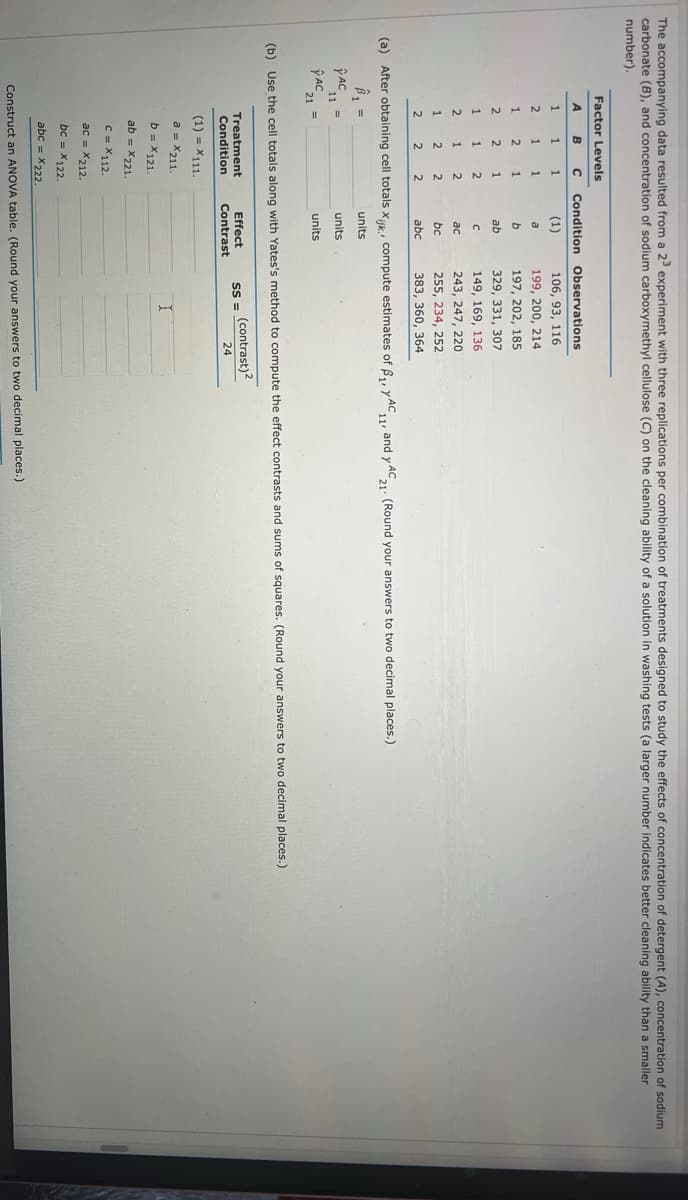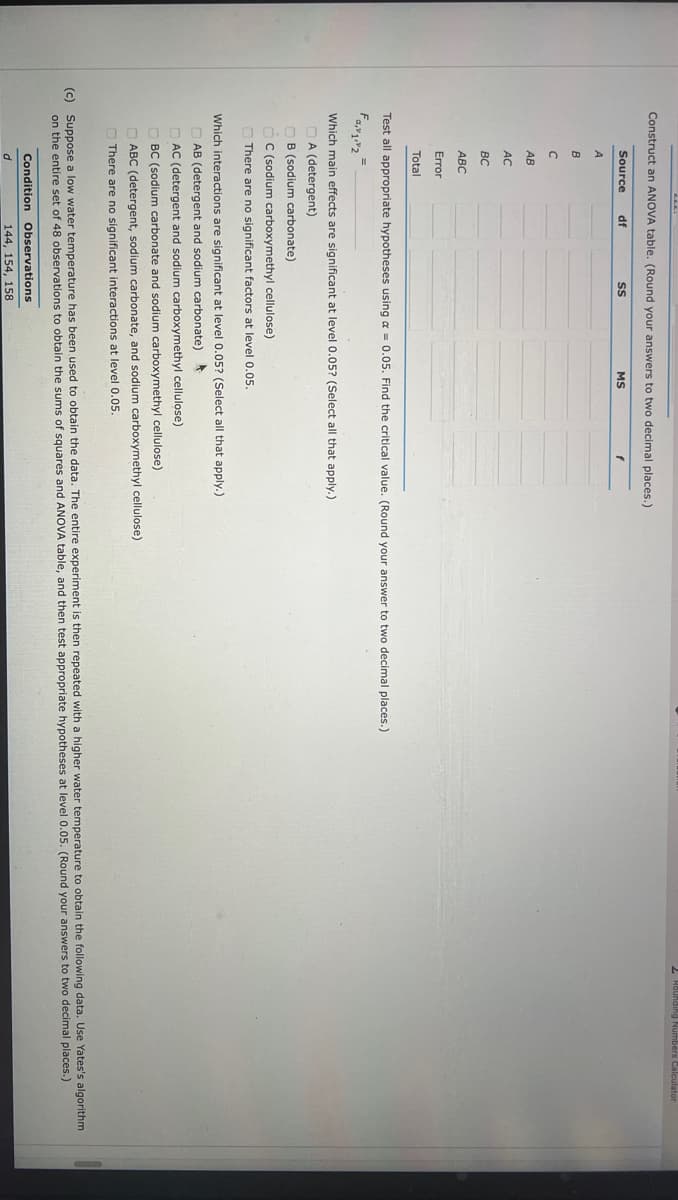The accompanying data resulted from a 23 experiment with three replications per combination of t carbonate (B), and concentration of sodium carboxymethyl cellulose (C) on the cleaning ability of a number). AC Factor Levels A 1 2 11 AC 1 2 21 1 2 1 2 = B с Condition 1 1 (1) a b ab с ac bc abc = 1 2 1 1 2 1 1 2 1 2 22 (a) After obtaining cell totals Xijk. compute estimates of B₁, YAC11, and yAC2 (Round your ans 21° units units units NNNN 2 2 Treatment Condition Observations 106, 93, 116 199, 200, 214 197, 202, 185 329, 331, 307 149, 169, 136 243, 247, 220 (b) Use the cell totals along with Yates's method to compute the effect contrasts and sums of sc (contrast)² 24 (1) = x111. a = x211. b = x121. 255, 234, 252 383, 360, 364 Effect Contrast SS= ab = X221. C = X112. ac = x212. bc = x122. abc = X222. Construct an ANOVA table. (Round your answers to two decimal places.)
The accompanying data resulted from a 23 experiment with three replications per combination of t carbonate (B), and concentration of sodium carboxymethyl cellulose (C) on the cleaning ability of a number). AC Factor Levels A 1 2 11 AC 1 2 21 1 2 1 2 = B с Condition 1 1 (1) a b ab с ac bc abc = 1 2 1 1 2 1 1 2 1 2 22 (a) After obtaining cell totals Xijk. compute estimates of B₁, YAC11, and yAC2 (Round your ans 21° units units units NNNN 2 2 Treatment Condition Observations 106, 93, 116 199, 200, 214 197, 202, 185 329, 331, 307 149, 169, 136 243, 247, 220 (b) Use the cell totals along with Yates's method to compute the effect contrasts and sums of sc (contrast)² 24 (1) = x111. a = x211. b = x121. 255, 234, 252 383, 360, 364 Effect Contrast SS= ab = X221. C = X112. ac = x212. bc = x122. abc = X222. Construct an ANOVA table. (Round your answers to two decimal places.)
A First Course in Probability (10th Edition)
10th Edition
ISBN:9780134753119
Author:Sheldon Ross
Publisher:Sheldon Ross
Chapter1: Combinatorial Analysis
Section: Chapter Questions
Problem 1.1P: a. How many different 7-place license plates are possible if the first 2 places are for letters and...
Related questions
Question

Transcribed Image Text:The accompanying data resulted from a 23 experiment with three replications per combination of treatments designed to study the effects of concentration of detergent (A), concentration of sodium
carbonate (B), and concentration of sodium carboxymethyl cellulose (C) on the cleaning ability of a solution in washing tests (a larger number indicates better cleaning ability than a smaller
number).
Factor Levels
A
1
2
AC
Y AC
1
2
1
2
1
2
11
B с Condition
(1)
a
b
ab
с
ac
bc
abc
=
1
1
2
2
1
1
1
1
1
2
1
2
2
2
2 2
(a) After obtaining cell totals Xijk. compute estimates of ₁, YAC11, and yAC 21. (Round your answers to two decimal places.)
B₁ =
units
units
units
(b) Use the cell totals along with Yates's method to compute the effect contrasts and sums of squares. (Round your answers to two decimal places.)
(contrast)2
24
Treatment
Condition
Observations
106, 93, 116
199, 200, 214
197, 202, 185
329, 331, 307
149, 169, 136
243, 247, 220
255, 234, 252
383, 360, 364
(1) = X111.
a=X211.
b = x121.
ab=X221.
C = X112
ac X212.
Effect
Contrast
SS=
I
bc=X122.
abc = X222.
Construct an ANOVA table. (Round your answers to two decimal places.)

Transcribed Image Text:Construct an ANOVA table. (Round your answers to two decimal places.)
Source df
A
B
с
AB
AC
BC
ABC
Error
Total
SS
Test all appropriate hypotheses using a = 0.05. Find the critical value. (Round your answer to two decimal places.)
F12
Which main effects are significant at level 0.05? (Select all that apply.)
A (detergent)
OB (sodium carbonate)
C (sodium carboxymethyl cellulose)
There are no significant factors at level 0.05.
Which interactions are significant at level 0.05? (Select all that apply.)
AB (detergent and sodium carbonate)
AC (detergent and sodium carboxymethyl cellulose)
BC (sodium carbonate and sodium carboxymethyl cellulose)
ABC (detergent, sodium carbonate, and sodium carboxymethyl cellulose)
There are no significant interactions at level 0.05.
Condition
MS
d
(c) Suppose a low water temperature has been used to obtain the data. The entire experiment is then repeated with a higher water temperature to obtain the following data. Use Yates's algorithm
on the entire set of 48 observations to obtain the sums of squares and ANOVA table, and then test appropriate hypotheses at level 0.05. (Round your answers to two decimal places.)
Observations
144, 154, 158
2 Rounding Numbers Calculator
Expert Solution
This question has been solved!
Explore an expertly crafted, step-by-step solution for a thorough understanding of key concepts.
This is a popular solution!
Step 1: Write the given information.
VIEWStep 2: Compute cell total to determine the required estimates.
VIEWStep 3: Compute the effect contrast and sum of squares using Yate's method.
VIEWStep 4: Construct ANOVA table using the given data.
VIEWStep 5: Determine critical value for the significant main effects and interaction effects.
VIEWStep 6: Determine significant main effects and interaction effects.
VIEWSolution
VIEWTrending now
This is a popular solution!
Step by step
Solved in 7 steps with 5 images

Recommended textbooks for you

A First Course in Probability (10th Edition)
Probability
ISBN:
9780134753119
Author:
Sheldon Ross
Publisher:
PEARSON


A First Course in Probability (10th Edition)
Probability
ISBN:
9780134753119
Author:
Sheldon Ross
Publisher:
PEARSON
